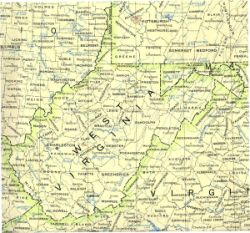 West Virginia, officially formed last month as a state by popular vote (but yet to be formally admitted to the Union), is on the side of the Union. Yet, Union control over the former western region of Confederate Virginia is tenuous. This weekend, Confederate forces exploit the weak Union presence in the town of Guyandotte (later to become a part of Huntington, West Virginia).
West Virginia, officially formed last month as a state by popular vote (but yet to be formally admitted to the Union), is on the side of the Union. Yet, Union control over the former western region of Confederate Virginia is tenuous. This weekend, Confederate forces exploit the weak Union presence in the town of Guyandotte (later to become a part of Huntington, West Virginia).
West Virginia historian Joe Geiger, Jr., recounts the events of November 10-11, 1861:
In the first week of November, Confederate General John B. Floyd ordered a cavalry force to “proceed in the direction of the Ohio River, and to strike the enemy a blow. . . .” The raid was led by Colonel John Clarkson, whose force numbered about seven hundred horsemen from the Fifth and Eighth Virginia Cavalry regiments, the latter led by Colonel Albert Jenkins. Clarkson’s cavalry departed from Camp Dickerson in Fayette County on November 4 and struggled through the rugged mountain wilderness, reaching the outskirts of Barboursville at sunset on November 10. The Confederate cavalry charged into town at full speed, capturing several Union sympathizers before crossing the Mud River and moving toward Guyandotte ….
Guyandotte was deceptively peaceful on Sunday night, November 10, 1861. Some of the recruits were returning home from worship services while others were visiting with friends or simply relaxing, unaware of the dramatic events about to unfold. The silence was shattered as the Confederates raced into town unopposed. A Union picket guarding a small bridge just outside the town had seen their approach, but he was so stunned by the sudden appearance of the enemy that he failed to fire a warning shot. The Border Rangers, headed by Captain James Corns, met another picket as they stormed the suspension bridge. Standing firmly in harm’s way, the Union soldier shot and killed one of the Border Rangers before being hit by return fire. Sedinger noted, “why he did not throw down and surrender was always a mystery to us. He was a small red headed man — would weigh about one hundred and forty pounds.” The Confederate company dismounted on the west side of the bridge as the remainder of Clarkson’s force began its attack.
When the first shots rang out, the Union soldiers dashed into the streets, curious as to the source of the commotion. The Ninth’s young drummer boy began sounding the alarm, but his instrument was pierced by a Confederate bullet. By the time the recruits realized they were under attack, it was too late. Many were cut off from their Enfield rifles and were unable to resist as the Confederate cavalry raced through the town hunting down Union troops and sympathizers. Some tried to flee across the suspension bridge but were cut down by the Border Rangers, who had secured this escape route.
Others who attempted to swim across the Guyandotte River were fired on by some of the town’s Confederate supporters gathered along the riverbank. Several witnesses later described the murder of a Union recruit attempting to swim across the river by a former sheriff of Cabell County, Wilson B. Moore. Moore apparently persuaded the youth that he would not be harmed if he surrendered. When the recruit reached shore, Moore aimed his revolver at the Union man and “discharged its contents into his head, literally blowing his brains out, mutilating his head in a shocking manner.” ….
On the morning of November 11, the Confederates tied their prisoners in pairs with rope readily supplied by a Guyandotte merchant. A quarter-inch rope was then used to bind each pair to the next, until all were tied together. As they were herded out of Guyandotte, the captured Union soldiers and citizens were subjected to verbal abuse by the town’s women, many of whom were wearing their “secession aprons.” ….
As the triumphant Confederates withdrew from Guyandotte with their prisoners in tow, the steamer SS Boston appeared, moving slowly up the Ohio River. Aboard were approximately two hundred Union soldiers from the Fifth Virginia Infantry, who had advanced from their camp in Ceredo after learning of the attack ….
The Union men then marched into Guyandotte, where they found a number of dead and wounded comrades and heard reports citing collaboration between some of the townspeople and the Confederate cavalry. The rage of the gathered Union troops and sympathizers now boiled over. Most accounts of the incident accuse Colonel John Zeigler of issuing orders to burn Guyandotte. Whether or not orders were given is irrelevant, since according to one observer, “three regiments would not have prevented them from burning the town.”
The business section of Guyandotte was completely gutted, purportedly to prevent the Confederates from returning for supplies. The Buffington Mill was burned, as was the Forest Hotel. Even churches were not immune from the torch. The Guyandotte Baptist Church was burned after two unsuccessful attempts when Union soldiers tore off the shutters and stuffed them with straw before setting them alight in the church belfry. The Guyandotte Methodist Episcopal Church, South may also have been burned.
Many houses were set ablaze, with special attention given to the town’s most prominent secessionists. Women and children were forced into the streets, and some of the residents reportedly had to leap out of windows to escape the flames ….
In the years of war to come, many more Baptist churches are destroyed throughout the South.
Source: Joe Geiger, Jr., “The Tragic Fate of Guyandotte,” West Virginia History 54 (1995): 28–41 (link)


